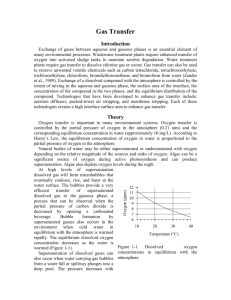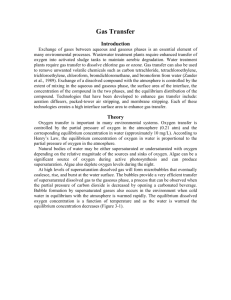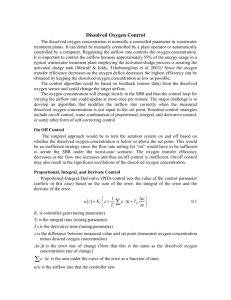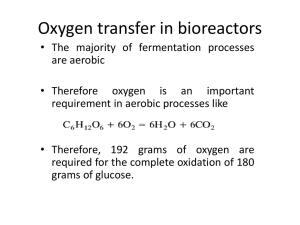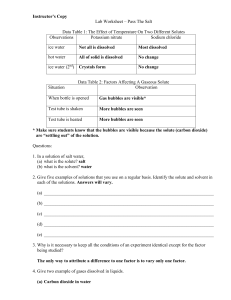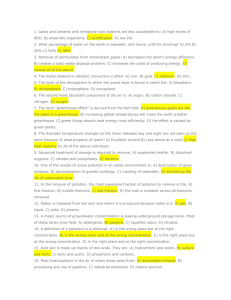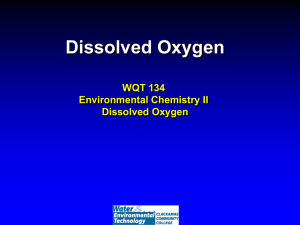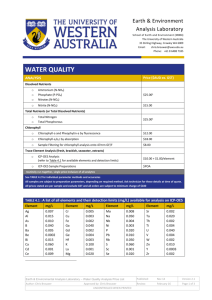Gas Transfer Coefficient
advertisement
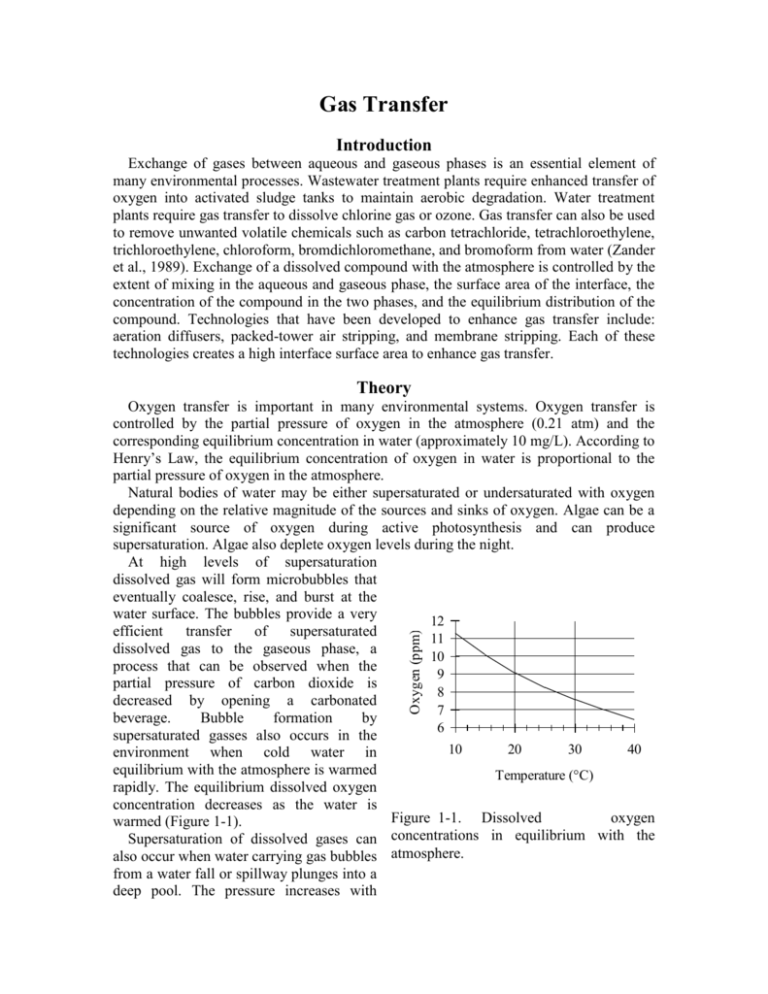
Gas Transfer Introduction Exchange of gases between aqueous and gaseous phases is an essential element of many environmental processes. Wastewater treatment plants require enhanced transfer of oxygen into activated sludge tanks to maintain aerobic degradation. Water treatment plants require gas transfer to dissolve chlorine gas or ozone. Gas transfer can also be used to remove unwanted volatile chemicals such as carbon tetrachloride, tetrachloroethylene, trichloroethylene, chloroform, bromdichloromethane, and bromoform from water (Zander et al., 1989). Exchange of a dissolved compound with the atmosphere is controlled by the extent of mixing in the aqueous and gaseous phase, the surface area of the interface, the concentration of the compound in the two phases, and the equilibrium distribution of the compound. Technologies that have been developed to enhance gas transfer include: aeration diffusers, packed-tower air stripping, and membrane stripping. Each of these technologies creates a high interface surface area to enhance gas transfer. Theory Oxygen (ppm) Oxygen transfer is important in many environmental systems. Oxygen transfer is controlled by the partial pressure of oxygen in the atmosphere (0.21 atm) and the corresponding equilibrium concentration in water (approximately 10 mg/L). According to Henry’s Law, the equilibrium concentration of oxygen in water is proportional to the partial pressure of oxygen in the atmosphere. Natural bodies of water may be either supersaturated or undersaturated with oxygen depending on the relative magnitude of the sources and sinks of oxygen. Algae can be a significant source of oxygen during active photosynthesis and can produce supersaturation. Algae also deplete oxygen levels during the night. At high levels of supersaturation dissolved gas will form microbubbles that eventually coalesce, rise, and burst at the water surface. The bubbles provide a very 12 efficient transfer of supersaturated 11 dissolved gas to the gaseous phase, a 10 process that can be observed when the 9 partial pressure of carbon dioxide is 8 decreased by opening a carbonated 7 beverage. Bubble formation by 6 supersaturated gasses also occurs in the 10 20 30 40 environment when cold water in equilibrium with the atmosphere is warmed Temperature (°C) rapidly. The equilibrium dissolved oxygen concentration decreases as the water is Figure 1-1. Dissolved oxygen warmed (Figure 1-1). concentrations in equilibrium with the Supersaturation of dissolved gases can also occur when water carrying gas bubbles atmosphere. from a water fall or spillway plunges into a deep pool. The pressure increases with depth in the pool and gasses carried deep into the pool dissolve in the water. When the water eventually approaches the surface the pressure decreases and the dissolved gases come out of solution and form bubbles. Bubble formation by supersaturated gases can kill fish (similar to the “bends” in humans) as the bubbles form in the bloodstream. Gas Transfer Coefficient Gas transfer rate can be modeled as the product of a driving force (the difference between the equilibrium concentration and the actual concentration) and an overall volumetric gas transfer coefficient (a function of the geometry, mixing levels of the system and the solubility of the compound). In equation form dC ˆ k v ,l C * C dt 1.1 where C is the dissolved gas concentration, C* is the equilibrium dissolved gas concentration and kˆv ,l is the overall volumetric gas transfer coefficient . Although kˆv ,l has dimensions of 1/T, it is a function of the interface surface area (A), the liquid volume (V), the oxygen diffusion coefficient in water (D), and the thickness of the laminar boundary layer () through which the gas must diffuse before the much faster turbulent mixing process can disperse the dissolved gas throughout the reactor. kˆv ,l f ( D, , A,V ) 1.2 The overall volumetric gas transfer coefficient is system specific and thus must be evaluated separately for each oxygen gas system of interest (Weber and Digiano, 1996). A schematic of the gas transfer process dissolv ed is shown in Figure 1-2. Fickian diffusion oxygen V / A controls the gas transfer in the laminar boundary layer. The oxygen concentration C in the bulk of the fluid is assumed to be C* homogeneous due to turbulent mixing and the oxygen concentration above the liquid Figure 1-2. Single film model of interphase mass transfer of oxygen. is assumed to be that of the atmosphere. The gas transfer coefficient will increase with the interface area and the diffusion coefficient and will decrease with the reactor volume and the thickness of the boundary layer. The functional form of the relationship is given by AD kˆv ,l V 1.3 Equation 1.1 can be integrated with appropriate initial conditions to obtain the concentration of oxygen as a function of time. However, care must be taken to ensure that the overall volumetric gas transfer coefficient is not a function of the dissolved oxygen concentration. This dependency can occur where air is pumped through diffusers on the bottom of activated sludge tanks. Rising air bubbles are significantly depleted of oxygen as they rise through the activated sludge tank and the extent of oxygen depletion is a function of the concentration of oxygen in the activated sludge. Integrating equation 1.1 with initial conditions of C = C0 at t = t0 C ln t dC C C* C t kˆv,l dt 0 0 1.4 C* C kˆv ,l (t t0 ) C * C0 1.5 Equation 1.5 can be evaluated using linear regression so that kˆv ,l is the slope of the line. The simple gas transfer model given in equation 1.5 is appropriate when the gas transfer coefficient is independent of the dissolved gas concentration. This requirement can be met in systems where the gas bubbles do not change concentration significantly as they rise through the water column. This condition is met when the water column is shallow, the bubbles have large diameters, or the difference between the concentration of dissolved gas and the equilibrium concentration is small. Oxygen Transfer Efficiency An important parameter in the design of aeration systems for the activated sludge process is the energy cost of compressing air to be pumped though diffusers. The pumping costs are a function of the pressure and the airflow rate. The pressure is a function of the hydrostatic pressure (based on the depth of submergence of the diffusers) and the head loss in the pipes and through the diffuser. The required airflow rate is a function of the BOD of the wastewater and the efficiency with which oxygen is transferred from the gas phase to the liquid phase. This oxygen transfer efficiency (OTE) is a function of the type of diffuser, the diffuser depth of submergence, as well as temperature and ionic strength of the activated sludge. Oxygen transfer is a remarkably inefficient process; only a small fraction of the oxygen carried by the rising bubbles diffuses into the activated sludge. The most efficient systems use membrane diffusers and achieve an OTE of approximately 10%. The manufacturer typically provides oxygen transfer efficiency for a specific diffuser. In this laboratory we will measure oxygen transfer efficiency for the aeration stone that we will be using in an activated sludge tank. The molar transfer rate of oxygen through the diffuser is ngas o2 Qair Pair f O2 RT 1.6 where f O2 is the molar fraction of air that is oxygen (0.21), Qair is the volumetric flow rate of air into the diffuser, Pair is the air pressure immediately upstream from the diffuser, R is the universal gas constant and T is absolute temperature. If the airflow rate is already given with units of moles/s then the molar transfer rate of oxygen can be obtained by multiplying by the molar fraction of air that is oxygen. The molar rate of dissolution into the aqueous phase is naq o2 V dC MWO2 dt 1.7 dC is the dt change in aqueous oxygen concentration with time. The rate of change of oxygen concentration is a function of the dissolved oxygen concentration and is a maximum when the dissolved oxygen concentration is zero. Oxygen transfer efficiency could be measured for any dissolved oxygen concentration. A better method of analysis is to dC substitute the right side of equation 1.1 for . dt where MWO2 is the molecular weight of oxygen, V is the reactor volume, and naq o2 Vkˆv ,l C * C MWO2 1.8 The oxygen transfer efficiency is the ratio of equation 1.8 to equation 1.6. OTE kˆv ,l C * C VRT MWO2 Qair Pair fO2 1.9 Measurement of OTE using equation 1.9 requires that the gas transfer coefficient, air flow rate, air pressure, and the air temperature be measured. (Pair and Qair have to correlate and in this experiment the best combination is atmospheric pressure and the flow rate given by the pump.) If the molar airflow rate is controlled then OTE is based on the ratio of equation 1.8 to the molar transfer rate of supplied oxygen. OTE naq o2 fO2 nair Vkˆv ,l C * C f O2 nair MWO2 1.10 Deoxygenation To measure the reaeration rate it is necessary to first remove the oxygen from the reactor. This can be accomplished by bubbling the solution with a gas that contains no oxygen. Nitrogen gas is typically used to remove oxygen from laboratory reactors. Alternately, a reductant can be used. Sulfite is a strong reductant that will reduce dissolved oxygen in the presence of a catalyst. cobalt O 2 2SO32 2SO 42 1.11 The mass of sodium sulfite required to deoxygenate a mg of oxygen is calculated from the stoichiometry of equation 1.11. 2 mole Na 2SO3 126,000 mg Na 2SO3 7.875 mg Na 2SO3 mole O2 32000 mg O2 mole O2 mole Na 2SO3 mg O2 1.12 If complete deoxygenation is desired a 10% excess of sulfite can be added. The sulfite will continue to react with oxygen as oxygen is transferred into the solution. The oxygen concentration can be measured with a dissolved oxygen probe or can be estimated if the temperature is known and equilibrium with the atmosphere assumed (Figure 1-1). Experimental Objectives The objectives of this lab are to: 1) Illustrate the dependence of gas transfer on gas flow rate. 2) Develop a functional relationship between gas flow rate and gas transfer. 3) Measure the oxygen transfer efficiency of a course bubble diffuser. 4) Explain the theory and use of dissolved oxygen probes. See http://ceeserver.cee.cornell.edu/mw24/Labdocumentation/sensors.htm for information on how the dissolved oxygen probe works. A small reactor that meets the conditions of a constant gas transfer coefficient will be used to characterize the dependence of the gas transfer coefficient on the gas flow rate through a simple diffuser. The gas transfer coefficient is a function of the gas flow rate because the interface surface area (i.e. the surface area of the air bubbles) increases as the gas flow rate increases. Experimental Methods 2 S 1 S 2 N The reactors are 4 L containers 7 kPa (Figure 6-3). Pressure Accumulator 200 kPa DO probe sensor The DO probe Pressure (optional) sensor should be Temperature probe (optional) placed to Stir bar minimize the risk of air Needle Valve Solenoid Valve bubbles 1.5 mm ID x 5 cm restriction lodging on the Air Supply membrane on the bottom of Figure 1-3. Apparatus used to measure reaeration rate. the probe. The aeration stone is connected to a source of regulated air flow. A 7-kPa pressure sensor (optional) can be used to measure the air pressure immediately upstream from the diffuser stone. A 200kPa pressure sensor is used to measure the air pressure in the accumulator. Initial Setup 1) Assemble the apparatus (don’t forget the 1.5 mm x 5 cm restriction). 2) Install a membrane on the oxygen probe. 3) Add 4 L of tap water to the reactor. 4) Open the Process Controller software. 5) Configure the Process Controller software (http://ceeserver.cee.cornell.edu/mw24/cee453/NRP/configure_PC.htm) 6) Set the Process Controller to Automatic Operation. 7) Set the state to “prepare to calibrate.” The process controller should quickly cycle through the calibration step and then begin attempting to control the air flow rate to the target value. 8) Set the stirrer speed to 5. 9) Calibrate the DO probe (See http://ceeserver.cee.cornell.edu/mw24/Software/DOcal.htm). Use 22ºC as the temperature. 10) Add 10 mg CoCl2· 6H2O (note this only needs to be added once because it is the catalyst). A stock solution of CoCl2· 6H2O (100 mg/mL – thus add 100 L) has been prepared to facilitate measurement of small cobalt doses. (Use gloves when handling cobalt!) Test the air flow controller In the following test the air flow controller should provide a constant flow of air into the accumulator. You can assess how well the air flow controller is working based on the slope of the pressure as a function of time. 1) Set the Process Controller to “Manual Locked in State.” 2) Set the state to off 3) Open the accumulator cap to empty the accumulator. 4) Close the accumulator cap. 5) Close the needle valve. 6) Set the air flow rate to 200 M/s. 7) Begin logging data at 1 s interval using the datalog button on the plant operation tab. Data is being logged when the icon is green. 8) Set the state to aerate. 9) End logging data when the accumulator pressure is approximately equal to the source pressure. 10) Analyze the data to see if the airflow rate is close to the expected value. If the error is greater than 20% look for leaks and recalibrate the airflow controller. Measure the Gas Transfer 1) Prepare to record the dissolved oxygen concentration using the Process Control software. Use 5-second data intervals and log the data to \\Enviro\enviro\Courses\453\your folder\gastran\ for later analysis. Include the flow rate in the file name. 2) Set the airflow rate to the desired flow rate. 3) Set the state to aerate. 4) Set the needle valve so the pressure in the accumulator is approximately 75% of the source pressure. 5) Wait until the accumulator pressure reaches steady state. 6) Turn the air off by changing the operator selected state to “OFF.” 7) Add enough sodium sulfite to deoxygenate the solution. A stock solution of sodium sulfite (100 mg/mL) has been prepared to facilitate measurement of small sulfite doses. Calculate this dose based on the measured dissolved oxygen concentration. (4 L of water at Coxygen mg O2/L = 4 Coxygen mg O2, therefore add 4(7.875)(Coxygen) mg sodium sulfite or 4(7.875)(Coxygen)/100 mL of stock solution.) 8) Turn the air on by changing the operator selected state to “Aerate.” 9) Monitor the dissolved oxygen concentration until it reaches 50% of saturation value or 10 minutes (whichever is shorter). 10) Repeat steps 1-9 to collect data from additional flow rates. 11) Consolidate the files into one spreadsheet file with a separate sheet for each flow rate. Prelab Questions 1) Calculate the mass of sodium sulfite needed to reduce all the dissolved oxygen in 4 L of pure water in equilibrium with the atmosphere and at 30°C. 2) Sketch your expectations for dissolved oxygen concentration as a function of time for the flow rates used on a single graph. The graph can be done by hand and doesn’t need to have any numbers on the time scale. 3) Why is kˆ not zero when the gas flow rate is zero? How can oxygen transfer into the v ,l reactor even when no air is pumped into the diffuser? 4) Sketch your expectations for kˆv ,l as a function of gas flow rate. Do you expect a straight line? Why? 5) Read http://ceeserver.cee.cornell.edu/mw24/cee453/NRP/Airflow%20Control.doc. Does the air flow controller control the airflow into the accumulator or out of the accumulator? Data Analysis This lab requires a significant amount of repetitive data analysis. Plan how you will organize your spreadsheet to make the analysis as easy as possible. 1) Calculate the air flow rate from testing the air flow controller and compare with the target value. 2) Eliminate the data from each data set when the dissolved oxygen concentration was less than 0.5 mg/L. This will ensure that all of the sulfite has reacted. 3) Plot a representative data set showing dissolved oxygen vs. time. 4) Calculate C * for based on the average water temperature, barometric pressure, 1727 2.105 T and the following equation. C * PO2 e where T is in Kelvin, PO2 is the partial pressure of oxygen in atmospheres, and C * is in mg/L. This equation is valid for 278 K<T<318 K. 5) Estimate kˆv ,l using linear regression and equation 1.5 for each data set. Use the slope function in Excel; don’t use the equation displayed on the trendline plot! 6) Create a graph with a representative plot showing the linearized data, C* C ln * vs. time, and the best-fit line. C C 0 7) Plot kˆ as a function of airflow rate (mole/s). v ,l 8) Plot the reaeration model on the same graph as the data. 9) Look at each dataset and if necessary eliminate more data from the beginning (or end) of the dataset. You will be able to see when the oxygen level is affected by residual sulfite at the beginning of the experiments. 10) Plot OTE as a function of airflow rate (mole/s) with the oxygen deficit ( C * C ) set at 6 mg/L. 11) Plot the oxygen dissolution rate (mole/s) as a function of the air supply rate (mole/s). 12) If the wastewater BOD is 325 mg/L and the wastewater flow rate is 16 L/day, what combination of airflow rate and diffusers would you use? You may assume that the entire BOD is consumed in the activated sludge tank, that C * for the wastewater is 8 mg/L and that the target dissolved oxygen concentration in the tank is 2 mg/L. 13) Comment on results and compare with your expectations and with theory. 14) Verify that your report and graphs meet the requirements. Check the course website for details. (http://www.cee.cornell.edu/mw24/cee453/Lab_Reports/editing_checklist.htm and (http://www.cee.cornell.edu/mw24/cee453/Lab_Reports/default.htm) References Weber, W. J. J. and F. A. Digiano. 1996. Process Dynamics in Environmental Systems. New York, John Wiley & Sons, Inc. Zander, A. K.; M. J. Semmens and R. M. Narbaitz. 1989. “Removing VOCs by membrane stripping” American Water Works Association Journal 81(11): 76-81. Lab Prep Notes Setup 1) Prepare the sodium sulfite immediately before class and distribute to groups in 15 mL PP bottles to minimize oxygen dissolution and reaction with the sulfite. 2) The cobalt solution can be prepared anytime and stored long term. Distribute to student stations in 15 mL PP bottles. 3) Verify that DO probes, membranes, and potassium chloride solutions are available at each station. Students will install the membranes. 4) Verify that the top row of ports has a maximum voltage of 0.5 volts and that middle row of ports has a maximum voltage of 0.1 volts. 5) Provide clamps to mount DO probes on magnetic stirrers. Major elements of apparatus air flow hardware (built by students) reactor hardware (built by students) sensors (plugged in to ports by TA) solenoid valves (already plugged in to ports by TA) software Table 1-1. Reagent list Description Supplier Na2SO3 CoCl2· 6H2O Fisher Scientific Fisher Scientific Table 1-2. reagent Na2SO3 CoCl2· 6H2O Stock solutions list M.W. g/100 mL 126.04 10 g 237.92 10 g Table 1-3. Catalog number S430-500 C371-100 mg/ mL 100 100 mL/ group 10 1 solubility g/L 125 770 Equipment list Description Supplier magnetic stirrer 100-1095 µL pipette 10-109.5 µL pipette 15 mL PP bottles Solenoid valves Stamp control boxes Pressure sensors 1 L airflow accumulators Fisher Scientific Fisher Scientific Catalog number 11-500-7S 13-707-5 Fisher Scientific 13-707-3 Fisher Scientific 02-923-8G Class Plan 1) Show how to install membrane on DO probe. 2) Show how to calibrate DO probe using Calibrator. Bench 1 2 3 4 5 6 7 8 Flows (M/s) 50, 100, 150 200, 250, 300 350, 400, 450 500, 600, 700 800, 900, 1000 1200, 1500, 2000 2500, 3000, 3500 4000, 4500, 5000
